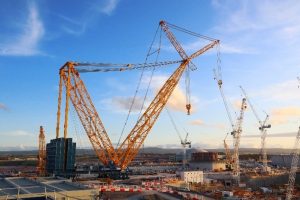
Big Carl ready for next big milestone
The world’s largest crane is ready to start work at the Hinkley Point C nuclear power station site. Able to stand up to 250m tall, “Big Carl” can reach higher than the tallest tower at London’s Canary Wharf and can carry 5,000 tonnes in a single lift.
The new Sarens SGC-250 crane was shown off on-site at Hinkley Point C today where it will be used to lift large prefabricated sections of the power station into place. The crane was developed to support the growing trend towards modularisation in big construction – and its deployment allows Hinkley Point C to exploit this innovation on a large scale.
The crane’s huge size and capacity allows large components to be built in covered factory conditions on site, improving quality and saving time. The success of prefabrication has already been proved during construction of the two operational EPRs built by EDF and CGN at Taishan in China. Its use at Hinkley Point C is another example of the innovation made possible by experience gained and applied from other nuclear construction projects.
Pipes in progress
Hinkley Point C’s Tier 1 contractor Socea Denys completed its biggest concrete pour to date in August, placing 1,900m3 of concrete for the Unit 1 inlet cooling water pipe. Construction of the cooling pipe means Bylor can start building the Unit 1 turbine building later in the year. The name ‘CRF’ comes from the French term ‘Circuit de Refroidissement’, meaning cooling water circuit.
Balfour Beatty has made significant progress in the construction of the cooling water tunnels, as the first permanent segment ring has been installed into intake tunnel 1. The ring is made up of six segments, all of which have been built by the Balfour Beatty team in the Avonmouth segment factory.
Liner cup takes shape
A specialist welding machine was used to perform 36 plasma welds for the first liner cup. The liner cup forms one of the five parts of the the first reator’s containment liner.
The high-quality welding process ensures the liner cup bottom is completely flat. Plates are then cut to complete the circular cup.
Pump House progress
The Bylor Heat Sink team is making progress constructing the Pump House. More than 9,000m³ of concrete has been poured to complete the first raft slab, which will reinforce and strengthen the Pump House and its cooling water system. A network of steel cylinder concrete pipes (SCCP), which will eventually transport seawater from the Bristol Channel to the condenser via the Pump House, has arrived on Site. The first concrete pour for the Unit 2 raft in the Heat Sink has begun and walls are being constructed for the 54m-high Pump House.
